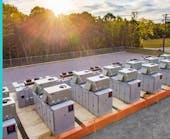Energy storage installations worldwide are expected to increase 20 times its current capacity to a cumulative 358 GW/1,028 GWh by the end of 2030, says research company BloombergNEF’s 2021 Global Energy Storage Outlook.
More than $262 billion will have to be invested to bring about such growth, BNEF estimates.More than half of these installations will take place in the U.S. and China.
In the U.S., the clean power goals of utilities and state governments are expected to drive this growth. In China, stricter renewable integration rules and an ambitious installation target of 30 GW by 2025 is expected to drive growth. India, Australia, Germany, the U.K. and Japan will be the other top markets in terms of energy storage installations. The growth in these countries will be supported by favorable policies, goals and the need for flexible energy resources.
Among regions, Asia-Pacific will lead on a megawatt basis but the Americas will build more on a megawatt-hour basis. This is mainly because the storage plants in the U.S. have higher storage hours. However, the Europe, Middle East and Africa region will lag due to the lack of favorable storage policies and incentives.
BNEF estimates that 55% of the energy storage installations by 2030 will provide energy shifting, like storing solar or wind energy for later use. The report also notes a rising popularity of co-located renewable-plus-storage projects, particularly solar-plus-storage.
Yiyi Zhou, clean power specialist at BNEF and lead author of the report, said: “The global storage market is growing at an unprecedented pace. Falling battery costs and surging renewables penetration make energy storage a compelling flexible resource in many power systems. Energy storage projects are growing in scale, increasing in dispatch duration, and are increasingly paired with renewables.”
The report (See graphic in image gallery) also notes a rapid evolution of battery technology and expects lithium-iron phosphate batteries to become the main lithium-ion battery chemistry choice in the energy storage sector by 2030. Moreover, many non-battery storage technologies, like compressed air and thermal energy storage, are also under development. Nevertheless, BNEF expects batteries to continue to dominate the market until the 2030s. This will be mainly due to their track record, established supply chain and price competitiveness.
Other findings:
· Growth in the EMEA region may accelerate as more fossil fuel generators exit, the penetration of renewables increases and the battery supply chain becomes more localized.
· Australia and California are sizeable markets for customer-sited batteries.
· Energy storage at homes and businesses is expected to make up one-fourth of the global installations, driven by a growing appetite for back-up power and desire to use self-generated solar power.





